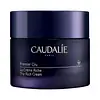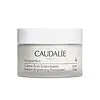What's inside
What's inside
 Key Ingredients
Key Ingredients

 Benefits
Benefits

 Concerns
Concerns

 Ingredients Side-by-side
Ingredients Side-by-side

Water
Skin ConditioningGlycerin
HumectantCaprylic/Capric Triglyceride
MaskingVitis Vinifera Seed Oil
EmollientHydrogenated Ethylhexyl Olivate
EmollientButyrospermum Parkii Butter Extract
Skin ConditioningCetearyl Alcohol
EmollientButylene Glycol
HumectantCetearyl Glucoside
EmulsifyingPropanediol
SolventPalmitoyl Grapevine Shoot Extract
AntioxidantPalmitoyl Grape Seed Extract
Skin ConditioningHydrogenated Olive Oil Unsaponifiables
EmollientPentaerythrityl Distearate
EmulsifyingPotassium Cetyl Phosphate
EmulsifyingCarbomer
Emulsion StabilisingCaprylyl Glycol
EmollientCeramide NP
Skin ConditioningXanthan Gum
EmulsifyingCI 77891
Cosmetic ColorantHydrolyzed Hyaluronic Acid
HumectantMagnolia Grandiflora Bark Extract
AntimicrobialPotassium Sorbate
PreservativeTocopherol
AntioxidantHelianthus Annuus Seed Oil
EmollientAdenosine
Skin ConditioningSodium Hydroxide
BufferingSodium Phytate
Geraniol
PerfumingLinalool
PerfumingCI 77491
Cosmetic ColorantPaeonia Lactiflora Root Extract
Skin ConditioningCI 77492
Cosmetic ColorantSodium Citrate
BufferingParfum
MaskingCitronellol
PerfumingWater, Glycerin, Caprylic/Capric Triglyceride, Vitis Vinifera Seed Oil, Hydrogenated Ethylhexyl Olivate, Butyrospermum Parkii Butter Extract, Cetearyl Alcohol, Butylene Glycol, Cetearyl Glucoside, Propanediol, Palmitoyl Grapevine Shoot Extract, Palmitoyl Grape Seed Extract, Hydrogenated Olive Oil Unsaponifiables, Pentaerythrityl Distearate, Potassium Cetyl Phosphate, Carbomer, Caprylyl Glycol, Ceramide NP, Xanthan Gum, CI 77891, Hydrolyzed Hyaluronic Acid, Magnolia Grandiflora Bark Extract, Potassium Sorbate, Tocopherol, Helianthus Annuus Seed Oil, Adenosine, Sodium Hydroxide, Sodium Phytate, Geraniol, Linalool, CI 77491, Paeonia Lactiflora Root Extract, CI 77492, Sodium Citrate, Parfum, Citronellol
Water
Skin ConditioningGlycerin
HumectantDicaprylyl Carbonate
EmollientSqualane
EmollientOctyldodecyl Myristate
EmollientC20-22 Alkyl Phosphate
EmulsifyingC20-22 Alcohols
Emulsion StabilisingPaeonia Lactiflora Root Extract
Skin ConditioningPalmitoyl Grapevine Shoot Extract
AntioxidantBisabolol
MaskingCitrus Aurantium Amara Flower Water
MaskingSaccharide Isomerate
HumectantNiacinamide
SmoothingParfum
MaskingCarbomer
Emulsion StabilisingSilica
AbrasiveCI 77891
Cosmetic ColorantEthylhexylglycerin
Skin ConditioningMica
Cosmetic ColorantSodium Hydroxide
BufferingSodium Phytate
Sodium Hyaluronate
HumectantCitric Acid
BufferingTin Oxide
AbrasiveSodium Citrate
BufferingTocopherol
AntioxidantPotassium Sorbate
PreservativeSodium Benzoate
MaskingWater, Glycerin, Dicaprylyl Carbonate, Squalane, Octyldodecyl Myristate, C20-22 Alkyl Phosphate, C20-22 Alcohols, Paeonia Lactiflora Root Extract, Palmitoyl Grapevine Shoot Extract, Bisabolol, Citrus Aurantium Amara Flower Water, Saccharide Isomerate, Niacinamide, Parfum, Carbomer, Silica, CI 77891, Ethylhexylglycerin, Mica, Sodium Hydroxide, Sodium Phytate, Sodium Hyaluronate, Citric Acid, Tin Oxide, Sodium Citrate, Tocopherol, Potassium Sorbate, Sodium Benzoate
 Reviews
Reviews

Ingredients Explained
These ingredients are found in both products.
Ingredients higher up in an ingredient list are typically present in a larger amount.
Carbomer is a polymer of acrylic acid. Its main role is to create a gel consistency.
A high amount of carbomer can cause pilling or balling up of products. Don't worry, most products contain 1% or less of carbomer.
Ci 77891 is a white pigment from Titanium dioxide. It is naturally found in minerals such as rutile and ilmenite.
It's main function is to add a white color to cosmetics. It can also be mixed with other colors to create different shades.
Ci 77891 is commonly found in sunscreens due to its ability to block UV rays.
Learn more about CI 77891Glycerin is already naturally found in your skin. It helps moisturize and protect your skin.
A study from 2016 found glycerin to be more effective as a humectant than AHAs and hyaluronic acid.
As a humectant, it helps the skin stay hydrated by pulling moisture to your skin. The low molecular weight of glycerin allows it to pull moisture into the deeper layers of your skin.
Hydrated skin improves your skin barrier; Your skin barrier helps protect against irritants and bacteria.
Glycerin has also been found to have antimicrobial and antiviral properties. Due to these properties, glycerin is often used in wound and burn treatments.
In cosmetics, glycerin is usually derived from plants such as soybean or palm. However, it can also be sourced from animals, such as tallow or animal fat.
This ingredient is organic, colorless, odorless, and non-toxic.
Glycerin is the name for this ingredient in American English. British English uses Glycerol/Glycerine.
Learn more about GlycerinWe don't have a description for Paeonia Lactiflora Root Extract yet.
Palmitoyl Grapevine Shoot Extract is an antioxidant.
Parfum is a catch-all term for an ingredient or more that is used to give a scent to products.
Also called "fragrance", this ingredient can be a blend of hundreds of chemicals or plant oils. This means every product with "fragrance" or "parfum" in the ingredients list is a different mixture.
For instance, Habanolide is a proprietary trade name for a specific aroma chemical. When used as a fragrance ingredient in cosmetics, most aroma chemicals fall under the broad labeling category of “FRAGRANCE” or “PARFUM” according to EU and US regulations.
The term 'parfum' or 'fragrance' is not regulated in many countries. In many cases, it is up to the brand to define this term.
For instance, many brands choose to label themselves as "fragrance-free" because they are not using synthetic fragrances. However, their products may still contain ingredients such as essential oils that are considered a fragrance by INCI standards.
One example is Calendula flower extract. Calendula is an essential oil that still imparts a scent or 'fragrance'.
Depending on the blend, the ingredients in the mixture can cause allergies and sensitivities on the skin. Some ingredients that are known EU allergens include linalool and citronellol.
Parfum can also be used to mask or cover an unpleasant scent.
The bottom line is: not all fragrances/parfum/ingredients are created equally. If you are worried about fragrances, we recommend taking a closer look at an ingredient. And of course, we always recommend speaking with a professional.
Learn more about ParfumPotassium Sorbate is a preservative used to prevent yeast and mold in products. It is commonly found in both cosmetic and food products.
This ingredient comes from potassium salt derived from sorbic acid. Sorbic acid is a natural antibiotic and effective against fungus.
Both potassium sorbate and sorbic acid can be found in baked goods, cheeses, dried meats, dried fruit, ice cream, pickles, wine, yogurt, and more.
You'll often find this ingredient used with other preservatives.
Learn more about Potassium SorbateSodium Citrate is the sodium salts of citric acid. In skincare, it is used to alter pH levels and acts as a preservative.
Its main functions are to maintain the pH of a product and neutralize metal ions.
The acidity of our skin is maintained by our glands and skin biome; normal pH level of skin is slightly acidic (~4.75-5.5).
Being slightly acidic allows our skin to create an "acid mantle". This acid mantle is a thin barrier that protects our skin from bacteria and contaminants.
Learn more about Sodium CitrateSodium Hydroxide is also known as lye or caustic soda. It is used to adjust the pH of products; many ingredients require a specific pH to be effective.
In small amounts, sodium hydroxide is considered safe to use. However, large amounts may cause chemical burns due to its high alkaline.
Your skin has a natural pH and acid mantle. This acid mantle helps prevent harmful bacteria from breaking through. The acid mantle also helps keep your skin hydrated.
"Alkaline" refers to a high pH level. A low pH level would be considered acidic.
Learn more about Sodium HydroxideSodium Phytate is the synthetic salt form of phytic acid. Phytic acid is an antioxidant and can be found in plant seeds.
Sodium Phytate is a chelating agent. Chelating agents help prevent metals from binding to water. This helps stabilize the ingredients and the product.
Tocopherol (also known as Vitamin E) is a common antioxidant used to help protect the skin from free-radicals and strengthen the skin barrier. It's also fat soluble - this means our skin is great at absorbing it.
Vitamin E also helps keep your natural skin lipids healthy. Your lipid skin barrier naturally consists of lipids, ceramides, and fatty acids. Vitamin E offers extra protection for your skin’s lipid barrier, keeping your skin healthy and nourished.
Another benefit is a bit of UV protection. Vitamin E helps reduce the damage caused by UVB rays. (It should not replace your sunscreen). Combining it with Vitamin C can decrease sunburned cells and hyperpigmentation after UV exposure.
You might have noticed Vitamin E + C often paired together. This is because it is great at stabilizing Vitamin C. Using the two together helps increase the effectiveness of both ingredients.
There are often claims that Vitamin E can reduce/prevent scarring, but these claims haven't been confirmed by scientific research.
Learn more about TocopherolWater. It's the most common cosmetic ingredient of all. You'll usually see it at the top of ingredient lists, meaning that it makes up the largest part of the product.
So why is it so popular? Water most often acts as a solvent - this means that it helps dissolve other ingredients into the formulation.
You'll also recognize water as that liquid we all need to stay alive. If you see this, drink a glass of water. Stay hydrated!
Learn more about Water